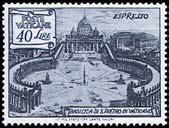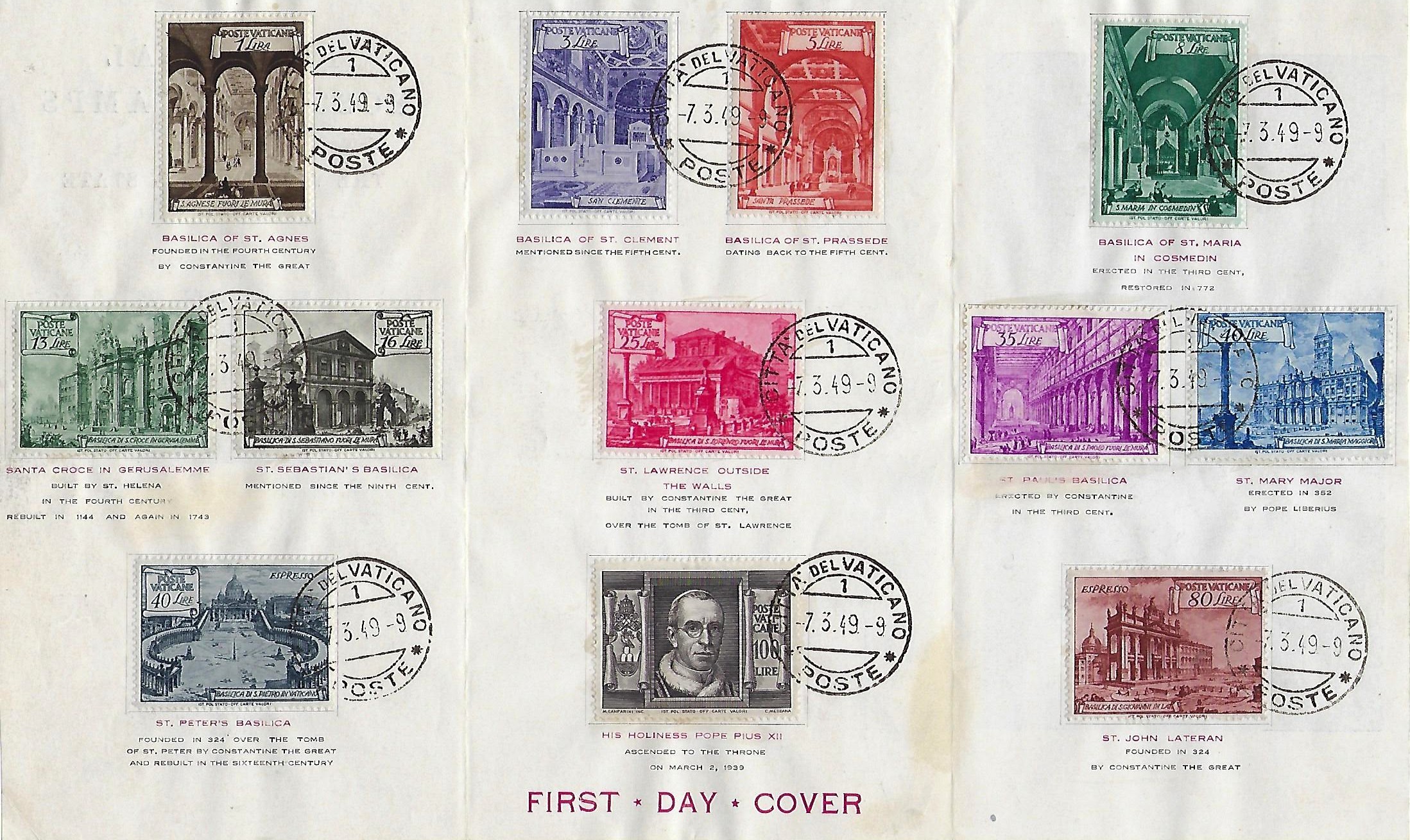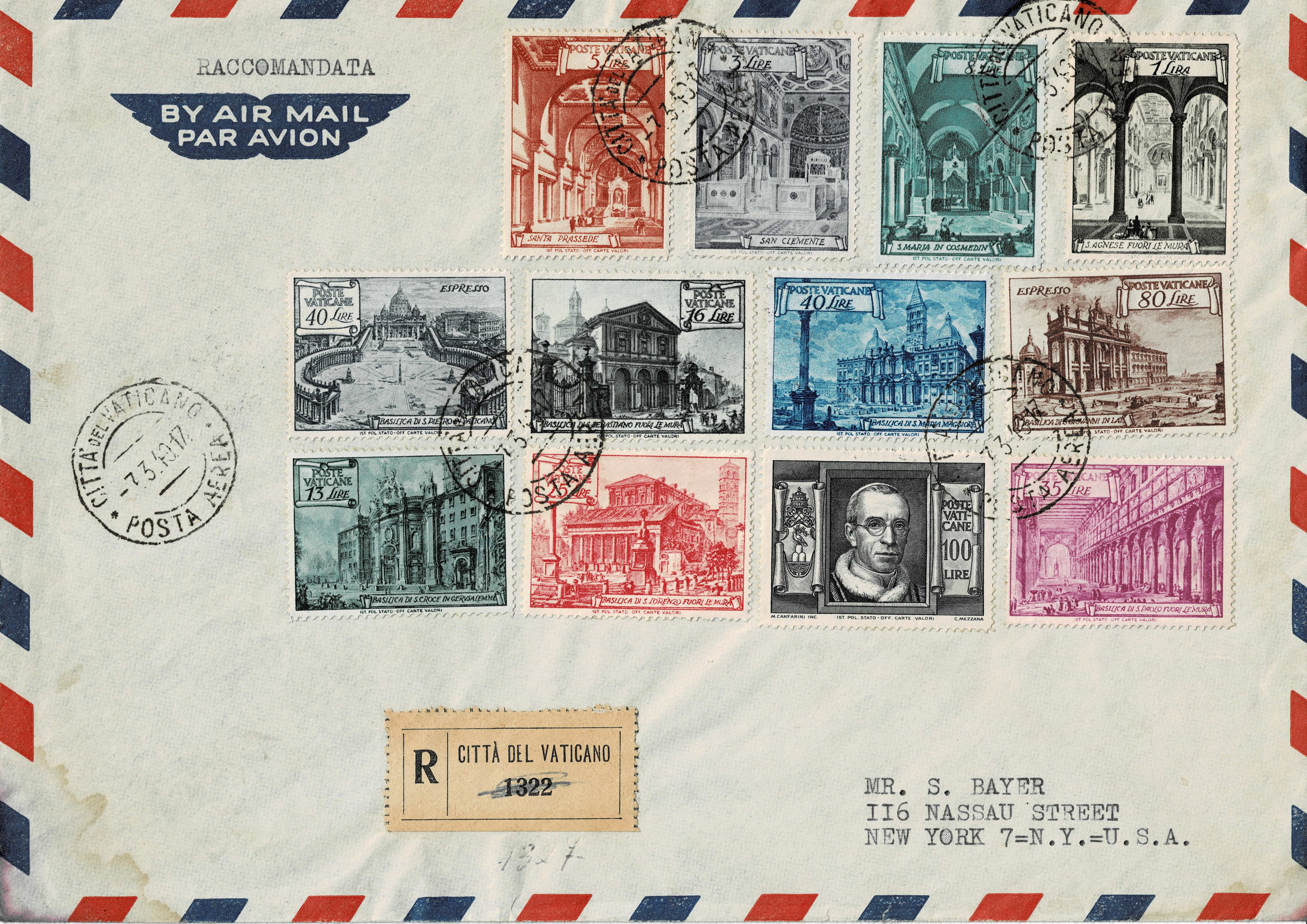
Home













On March 7, 1949, a new set of stamps for ordinary use was placed on sale for the first time. Each of these designs depicts one of the major basilicas and titular churches of Rome. In reality, this series of stamps was the forerunner of the Holy Year, as it publicized the major basilicas to be visited by the Holy Year pilgrims. The first stamp of the series depicts the Basilica of St. Agnes. This church originally was built over the tomb of this young martyr by the Emperor Constantine. During the Pontificate of Pope Symachus (498-514) the church was restored. A complete rebuilding of taken by. Pope Honorius I, during his reign (625-640). On St. Agnes' Day (January 21st) two lambs are placed on the altar and blessed. The lambs then are cared for by nuns until Easter when their wool is shorn to make the "Pallia." This again is blessed and worn by the Pope. The Pallia then is sent to new archbishops as a sign that they are in union with Rome and share in the plentitude of the episcopal office. The second basilica portrayed is that of St. Clement, the third Pope. The original basilica dates back to the fourth century when this church was erected on the foundations of the house of Clement. It was destroyed during one of the many sackings of Rome. In the year 1108, Pope Pascal II filled in the remains of the church and built a new edifice on its ruins, using many of the decorations from the original basilica. On the 8 lire stamp the Church of St. Prassede is shown. The present basilica was erected in 822, by Pope Pascal II. During the Pontificate of Pope Nicholas V it was restored, as well as in the years 1832 and 1869. One of the outstanding features of the church is the column at which Christ was scourged. In the crypt of this church, noted for its mosaics, are the remains of Saints Prassede and Prudentiana. The Church of St. Mary of Cosmedin was built on the site of an ancient Roman temple. It was constructed in the sixth century for the Greeks living in the area and originally named St. Maria in Schola Greca. In 782, it was reconstructed by Pope Adrian I who gave it the name of St. Mary of Cosmedin. The word "Cosmedin" comes from the Greek meaning, ornament. Two versions for this word have been given, the first states that it means the church was dedicated to Our Lady of Adornment, while the second version claims it refers the adornment of the church it-self. The Church of the Holy Cross of Jerusalem (13 Lire stamp) was erected by the Empress Helena, the Mother of Constantine. She journeyed to the Holy Land to obtain relics of the Crucifixion and to build in Rome a shrine for those who were unable to make a pilgrimage to the land of Christ's Passion. Among the relics preserved in this basilica are: a portion of the True Cross, the inscription placed over the head of Christ on the first Good Friday, one of the nails that pierced His holy body, thorns from the crown of the Savior, and the finger Thomas placed in the side of Christ to affirm it truly was the Savior. The church was rebuilt and remodelled many times in past centuries so that it does not represent the original structure erected by the Empress Helena. The. Church of St. Sebastian was named after a young Praetorian Guard officer of the reign of Dioceletian. He was accused of being a Christian and condemned to be shot to death by arrows. Miraculously he survived and returned to his duties where he confronted the emperor and reprimanded him for his cruelty to the Christians. He was again sentenced to death, this time to be beaten with clubs and his body to be thrown in the sewer. The corpse was recovered by a government official's wife, Lucina, and buried near a chapel where the bodies of St. Peter and St. Paul had been taken a few years before for safe keeping. A church was erected in the Middle Ages in honor of this soldier martyr and it is now one of the seven Pentitential Basilicas of Rome. Another of the Basilicas erected by the Emperor Constantine is that of St. Lawrence outside-the-walls. It was rebuilt and enlarged during the reign of Pope Pelagius II. It was again remodeled by Pope Honorius III and changed extensively. On July 19, 1943, the basilica was hit by a bomb damaging the roof, walls, and pillars. The work of restoring this famous church again was undertaken. One of the notable additions is a marble monument to Pius XII for his efforts in removing the Eternal City from the list of military targets. The Basilica of St. Paul out-side-the-walls (35 Lire value) originally was built by Constantine to mark the grave of this Apostle. While Emperor Valentinian II reignea, he began a new church on this sacred ground. The structure finally was finished during the Pontificate of Pope Honorius. It was destroyed in the great fire of 1823. Immediately after the inferno ended, Pope Leo XII began the reconstruction of St. Paul's Basilica. It was finished during the reign of Pope Pius IX and solemnly consecrated in 1854. Tradition claims that the church also marks the spot where Peter and Paul parted to go to their martyrdom, Peter by crucifixion and. Paul by beheading. The Basilica of St. Mary Major is the main basilica in Rome dedicated to the Mother of God. The Basilica was built by Pope Liberius (325-366) after a vision of the Holy Virgin appeared to him on the night of August 5, 352, and instructed him to build a church on the Esquine Hill on the spot where snow would be found in the morning. The basilica was erected and named St. Mary of the Snows. During the Pontificate of Pope Sixtus III, (432-440) the church was remodelled and dedicated to St. Mary, Mother of God. This church, dedicated to the Blessed Virgin Mary, was the scene of the opening ceremonies of the Marian Year, on December 8, 1953. This special jubilee extends to December 8, 1954, the first centenary of the Dogma of the Immaculate Conception. St. Peter's Basilica is portrayed on. the 40 lire special delivery stamp of this issue. The church was erected over the tomb of the first Vicar of Christ. As many of the ceremonies were held here, Popes of the early church erected a simple dwelling to house themselves and entourage overnight after the rites at the basilica. As time went on the simple dwelling assumed the proportions of a palace. In the year 1377, Pope Gregory XI returned to Rome from Avignon, France. Instead of taking residence at the Lateran Palace as his predecessors before their move to France, he chose to live alongside St. Peter's Basilica. This was the real beginning of the Vatican as we know it today. If it were not for the tomb of St. Peter, the Vatican City State would not be where it is today. St. John Lateran, Cathedral Church of the Pope, was founded by Constantine and presented to Pope Sylvester I as his official residence. Subsequent Popes also resided here until the move of the Papacy to Avignon in 1307. Originally, the church was dedicated to the Holy Savior. In 898 it was destroyed by fire and a new edifice erected and dedicated to St. John the Baptist. Fire again ravaged the basilica in 1308. Again it was rebuilt by Pope Clement V. The following Popes extended and remodeled the church to such a degree that its original form no longer is recognizable. Among the sacred relics found in the Basilica of St. John Lateran are the heads of Saints Peter and Paul enshrined in the high altar, and a table taken from the catacombs that was used by St. Peter as an altar. The Church of St. John Lateran not only is the Cathedral Church of the Popes, but also is the Mother and Head of all Churches, the Cathedral Church of Rome, and of the Catholic world. It has also been the scene of many ecclesiastical conclaves known as "The Councils of the Lateran." The basilicas as represented on this series have been taken from old engravings and are not replicas of the churches as they exist today. This issue of stamps is completed by a 100 lire value portraying His Holiness, Pope Pius XII. |
| (National Philatelic Museum, Volume VII, Number 1, 1954, pages 61-107) We are greatful to the Cardinal Spellman Philatelic Museum for allowing the Vatican Philatelic Society to use the copyrighted text on our website. |

